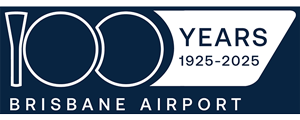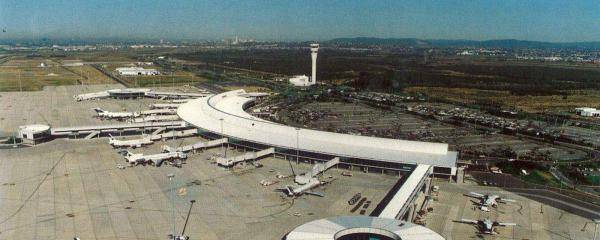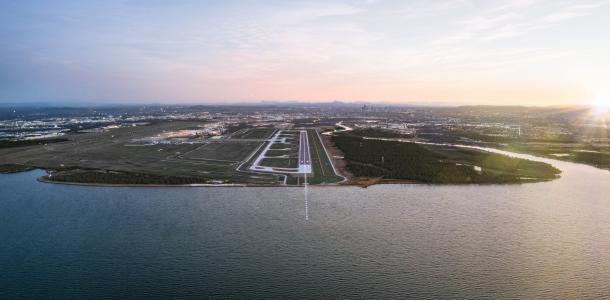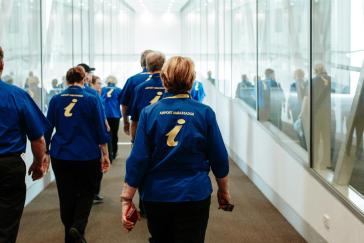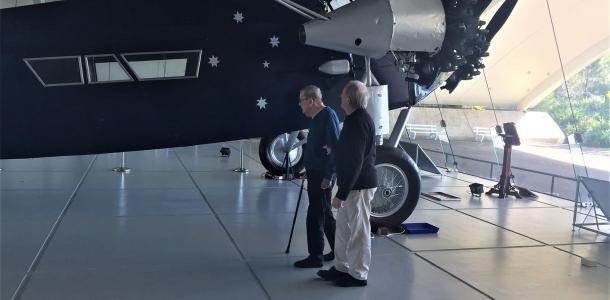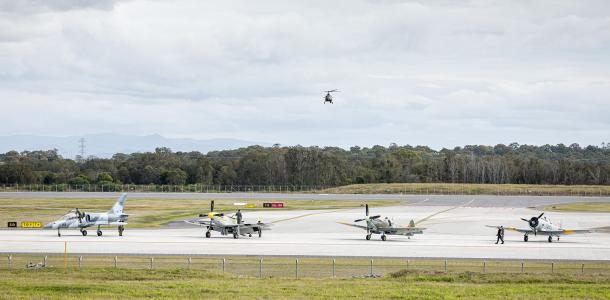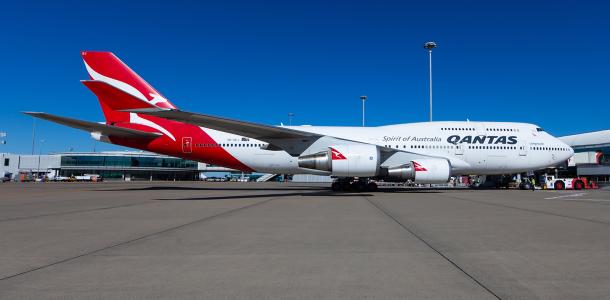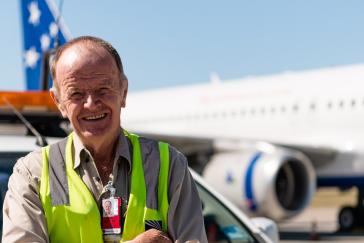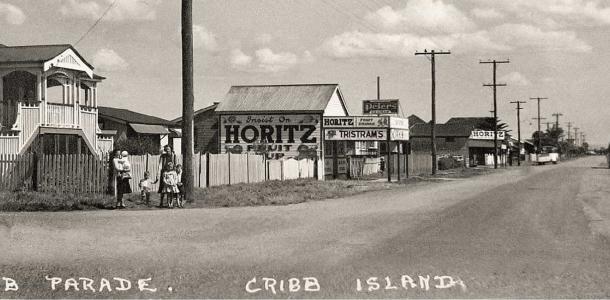For a century, Brisbane Airport has connected our region to the world.
2025 marks 100 years of our growth from a tiny aerodrome in Eagle Farm to one of the world's best airports located on Moreton Bay.
In 1925, the Commonwealth Government officially opened Eagle Farm Aerodrome on 36 hectares of former agricultural land. In the same year, Brisbane City Council was established.
In 1988, Brisbane Airport was moved 5km away from the growing city towards the edge of Moreton Bay to our current location to prepare to welcome the world to Expo 88.
For a century, Brisbane Airport has played a vital role in the development of our city into the vibrant, prosperous place it is today. In 2025, we celebrate our history as we build your future airport.
With Brisbane Airport set to surpass 50 million annual passengers by 2045, our next decade must focus on ensuring we have the right access to and from the airport, and the right facilities for passengers.
Future BNE delivers $5 billion of investment over the coming decade – including a third passenger terminal, major refurbishments to existing terminals, the region’s best connected commercial land, and much more – what’s happening at Brisbane Airport will change the way you travel, create jobs and prepare Brisbane for 2032 and beyond.

Brisbane Airport delivered a refreshed sustainability strategy and revised its commitment to be a Net Zero airport by 2025 (Scope 1 and 2).

One of the largest aviation construction projects undertaken in Australia at the time, works began in 2012 and officially opened in July 2020. With an investment of $1.1 billion the project generated 2,700+ construction jobs.
It has been estimated by 2035 the new runway will lead to the creation of 7,800 new jobs and contribute an additional $5 billion in annual economic benefit to the region.

A new airfield bridge was officially opened and named after John Hansford, who worked at Brisbane Airport for 51 years.

Brisbane Airport’s domestic passenger numbers more than halved in 2020-2021 due to Queensland’s border closures. Additionally, international passengers slumped by 95%.
In April 2021, the Trans-Tasman bubble was announced giving the green light to routes from Brisbane to New Zealand. This was followed steadily by domestic borders reopening and international routes being reinstated.
In FY24 Brisbane Airport saw a significant recovery with 22.6 million passengers or 95% of pre-COVID FY19 levels.

2019 is a record-breaking year for passenger numbers, with 24.1 million passengers passing through the airport.

This $120 million project marked the completion of the first portion of the critical link taxiways that connect the new runway to the existing runway and terminals.

The $135 million expansion of the International Terminal and Apron is officially opened by The Hon. Michael McCormack MP, Acting Prime Minister.

The Commonwealth Games Queens Baton Relay touches down at BNE in December 2017, prior to the Gold Coast Commonwealth Games.

Brisbane Airport is named Australia's first Dementia friendly Airport by Alzheimer's Australia.
The General Aviation precinct was upgraded to include an apron overlay, line marking for aircraft positions, installation of the Airport Storm Warning system and facilities improvement of baggage conveyors and dedicated pick-up and drop-off area.

China Eastern begins servicing BNE

Developed under the Global Reporting Initiative (GRI) Framework, the report highlighted some of Brisbane Airport Corporation’s recent initiatives, including improved waste management practices and community engagement and philanthropy work.
In addition to the release of the report, Brisbane Airport also achieved the first-ever Green Building Council of Australia (GBCA) Green Star – Communities rating.

Air Canada begins servicing BNE.

Brisbane Airport becomes the first Australian airport to formally commit to celebrating and promoting the traditions, laws and customs of First Nations people through a Reconciliation Action Plan.

The $45 million International Terminal redevelopment is officially opened.

Brisbane Airport unveils 750m long ‘Sensory Hug’ by acclaimed First Nations artist – the late Mirdidingkingathi Juwarnda Sally Gabori.

Brisbane Airport opens AIRPARK open air car park with shuttle bus to terminals.

The G20 was one of most important logistical events in Brisbane Airport’s history with the arrival and departure of more than 70 G20 aircraft.
The travelling public enjoyed minimal disruption whilst BNE welcomed the world to the G20 Leader’s Summit in Brisbane.
More than 70 State and support aircraft arrived and departed Australia via BNE, carrying the likes of Chinese President Xi Jinping, Japanese Prime Minister Shinzo Abe, Russian President Vladimir Putin and Indian PM Narendra Modi.
In total, 26 world leaders and their entourage used BNE, in what was the biggest weekend in the Airport’s history.

Featuring a 24-hour Shell Coles Express, 24-hour McDonald’s restaurant and a dine-in food court, the centre offers additional convenience for workers and passengers in the airport precinct.

Brisbane Airport’s first super jumbo service between Brisbane to Dubai.

Philippine Airlines begins servicing BNE.

Brisbane Airport opens a $180 million, nine-storey, 5,000 space car park including smart park-finding technology, CCTV cameras and undercover access to the terminal.

The airport precinct is recognised in its own right with official confirmation the area will be called the suburb of ‘Brisbane Airport’ using the postcode 4008.

The $350 million redevelopment included an expansion to the Central Area Satellite and terminal aprons, construction of an elevated Skywalk, new forecourt area and central taxi rank, and reconfiguration of the road network in front of the Terminal.

China Southern begins servicing BNE.

The aviation industry faced major challenges worldwide following the terrorist attack on the World Trade Centre, in New York including increased security and screening requirements.

Queensland Premier Anna Bligh officially opens Brisbane Airport’s second major access road, Moreton Drive.

The expansion included around 33,000 additional square metres of space across the four floors of the Terminal, and expanded and reconfigured airline processing, retail, customs, security and baggage areas.
The redeveloped Terminal was officially opened by Queensland Premier Anna Bligh.

A parallel runway system in which both runways can operate simultaneously is a clear and practical idea that was part of Brisbane Airport’s long-term planning for over four decades.
Unfortunately, construction was halted shortly after construction approval in the wake of the global financial crisis and a dip in passenger numbers.
Site preparation and reclamation works did not commence until July 2012. Due to the extremely poor strength soils of the site and the extent of the ground improvements necessary before construction could begin, five years were set aside for this phase alone.
Etihad Airways begins servicing BNE.

Jetstar begins servicing BNE.

Emirates begins servicing BNE.

EVA Airways begins servicing BNE.

China Airlines begins servicing BNE.
Airtrain rail services begin linking the airport to the CBD and Gold Coast.

Virgin Australia begins servicing BNE.

Brisbane Airport was purchased by Brisbane Airport Corporation for $1.4 billion under a 50-year lease with an option to renew a further 49 years. Under this unique leasehold tenure, Brisbane Airport Corporation retains ownership and control of the airport for the duration of the lease term up to 2096.
Construction for Brisbane Airport’s new $240 million International Terminal commenced in January 1993 and was expected to take two years.
The terminal was officially opened on 5 September 1995, by then Prime Minister Paul Keating, four months ahead of schedule and several million dollars below budget.
Approximately 42,000 square metres of profiled steel decking was used in the terminal and associated works.
The terminal was surrounded by 140,000 square metres of apron to facilitate 11 aircraft, including eight aerobridges, and had parking for 2,000 cars and 70 buses, as well as 55 hectares of landscaping.

Korean Airlines begins servicing BNE.

Site planning for a new International Terminal commences.

In March 1988 at 2.45 pm the last departure from the old airport took off on Runway 4. It was a special charity charter Ansett Boeing 767-277 VH-RME. The flight returned to the new Brisbane Airport.
The last arrival at the old airport was a Falcon 10 VH-DJT of Ariadne which arrived from WLG at approximately 9.15 pm landing on Runway 22.
Air Vanuatu begins servicing BNE.
Brisbane hosted World Expo ‘88 this year and the official opening was just in time to welcome passengers.

Solomon Airways begins servicing BNE.

The first commercial departure from the new Brisbane Airport runway 01R/19L, was a Qantas Boeing 747-238B VH-EBJ operating QF27 SYD-BNE-HKG with 410 passengers, weight of 331,010 kgs.
After residing at Amberley RAAF base since 1958, Sir Charles Kingsford-Smith’s ‘Southern Cross’ aircraft is moved to its current location at the Sir Charles Kingsford-Smith Memorial.

The new Brisbane Airport runway and tower is commissioned for operations.

Brisbane Airport joins the Federal Airport Corporation – the largest airport network in the world from 1986 – 1998.
Singapore Airlines begins servicing BNE.

Air Calin begins servicing BNE.
Cathay Pacific begins servicing BNE.

Thai Airways begins servicing BNE.

The total expenditure of building the new airport closer towards Moreton Bay was expected to be $300 million with completion expected in 1986. The actual cost to build the airport was $425 million.
14 million cubic metres of sand dredged from Moreton Bay was used to stabilise the otherwise swampy land for the new terminals, aprons, taxiways and runway.
Air New Zealand begins servicing BNE.

The first departure was QF956 with 134 passengers to Christchurch with the first arrival by Air New Zealand from Auckland with 33 passengers.
Fiji Airways begins servicing BNE.

This master plan included the long-term planning of a wide-spaced parallel runway system in a north-south alignment.
Planning for the new Brisbane Airport Domestic Terminal and International Terminal commenced.
Over the next decade more than 900 people were relocated from Cribb Island before construction began on the new Brisbane Airport.
This new site, five kilometres north of the existing site, necessitated the resumption of 60 houses in Lander’s Pocket and Lower Nudgee, some land from the Nudgee Golf Course and virtually all of the residential settlement at Cribb Island, famously known as a childhood home of Bee Gees pop stars Barry, Robin and Maurice Gibb.

First arrival of a jumbo jet (Qantas 747).

The Beatles were notable visitors to Brisbane Airport in 1964 arriving to thousands of screaming fans. Additionally, Princess Marina Duchess of Kent stopped over the same year.
The popularisation of air travel confirms the need for a new airport facility, resulting in 2,700 hectares of land being set aside for a new Brisbane Airport site.
First jet service (Qantas to London).
The airport had a number of well-known visitors this decade, including Queen Elizabeth II on her 1954 tour of Australia. She returned to Brisbane in 1963, 1970, 1988 and 2011.

Fiji Airways (Air Pacific) begins servicing BNE.
Roughly 6.4 km north-east of Brisbane’s CBD the site included one major runway bearing north-east to south-west 45.7 m wide and 2,365.2 m in length, with a secondary cross-runway bearing north-west to south-east 1,530.1 m long and 30.5 m wide.
Two Terminal buildings housed the domestic carriers Ansett and Trans Australia Airlines, while a third catered for all international services. All three of these Terminal buildings were wartime igloos erected to house military aircraft assembly and testing plants.
For a time, operations moved to Archerfield Airport but World War II saw operations reinstated at Eagle Farm as the preferred site for ongoing aviation in Brisbane.

Remnant sites from World War Two still present include an American built runway at the airport, and heritage-listed Hangar No. 7 and the former Allison Testing Stands in Eagle Farm.
Hangar 7 was used in secret for the reconstruction and research of Japanese aircraft during the war. It became a TAA cargo facility. Hangar 7 still exists today, managed by Brisbane City Council.
The Australian subsidiary of the General Motors Company, General Motors-Holden Limited, was contracted to establish an overhaul and assembly plant in an igloo warehouse at Breakfast Creek.
Eagle Farm was then used by the Royal Australian Air Force (RAAF) for training purposes until early 1942.
The area housed a number of Military camps. United States military personnel constructed two (and later a third) hard surface runways to replace the former grassed land fields.
This site was a part of an extensive series of airports and fields hastily constructed throughout Queensland and the Northern Territory during the War, in order to defend the nation and provide a launching pad for allied military forces back into Asia.
Eagle Farm was intended to act as a service and assembly facility for three to four thousand allied aircraft during the War.
With the urgent need for Terminal buildings, M.R. Hornibrook and Company was commissioned to erect a number of timber truss igloo structures.

It was held in storage for decades, before a 1955 Federal cabinet decision gifted the historic aircraft to the state of Queensland in recognition of Kingsford Smith’s birthplace in Brisbane.
The original ‘Southern Cross’ aircraft is now located on permanent public display at the Kingsford Smith Memorial on Airport Drive, opposite Brisbane Airport’s International Terminal.

Qantas International begins servicing BNE
Flight operations at Eagle Farm ceased with the site being considered too swampy. It was used for grazing land until the onset of World War II.
Miss Johnson was attempting to beat Australian Aviator, Bert Hinkler's record of London to Australia in 15 and a half days.

During the Great Depression of the 1930s many of the Cribb Island shack owners abandoned the area and a number of unemployed families took up residence.

Qantas Domestic begins servicing BNE.
Bert Hinkler completes the first solo flight from England landing at Eagle Farm Racecourse.
Travelling from the United States of America to Australia in the aircraft ‘Southern Cross’. They landed at Eagle Farm on 9 June 1928, greeted by a crowd of 25,000 people. The flight took 21 hours 21 minutes from Suva, Fiji to Brisbane.

The Eagle Farm Aerodrome opened under the control of the Civil Aviation Branch of the Department of Defence.

36 hectares of agricultural land at Eagle Farm, located 6 km north-east of Brisbane or 5 km south-west of Brisbane Airport's current Domestic Terminal was acquired by the Commonwealth Government as the site for Brisbane’s first airport.
Captain Jack Treacy, a World War I pilot, was the first to land his Sunbeam Avro aircraft, The Queen of Sheba, at Eagle Farm.

Captain Edgar C. Johnston, Federal Superintendent of Aerodromes, chose a location owned by two farmers (David Wilson and William Lynn) for development as a government Aerodrome.
Cribb Island became a popular seaside location, one of the closest sea bathing beaches to Brisbane. The area was popular with retirees and many people built small shacks as weekenders.

The Eagle Farm State School (later renamed Hendra State School) reported an enrolment of 156 boys and 116 girls demonstrating that a significant number of residents lived in the area.

The construction of the Brisbane to Sandgate railway line in 1882 and the Pinkenba line in 1897 encouraged an influx of people, stimulating industrial and agricultural growth.
An 1842 map shows that William Pitt Trevelyan, a former captain in the 93rd Highlanders bought land that contained the former female compound and stockyards. Another section was renamed Hollinorth Farm.
Mr John George Cribb purchased 156 acres of swampy crown land past Eagle Farm for £160. He cultivated bananas, pineapples, watermelons, peanuts and cotton.

They helped to build the road to Breakfast Creek, which follows the same route as Sir Kingsford Smith Drive does today.
All female convicts were removed from Eagle Farm by July 1839, but the site continued to function as a government cattle station until as late as 1841.
The reserve which is now the location of the airport control tower was created to supply the fledgling Moreton Bay penal colony, which was established in 1824.
By 1932, the land was used to farm maize, potatoes, cattle and pigs.
The area that is now Brisbane Airport began to be developed for use by the early European settlers.
The Turrbal people occupied the country from Logan to North Pine, and as far west as Moggill Creek.
Bora Rings (ceremonial grounds) are believed to have been used at Brisbane Airport and would have still been in use at the time of European Settlement.
The area is also known to have been the location for transient camps, including some at Cribb Island and Myrtletown.
Learn more about the Indigenous history of Brisbane Airport.

With Brisbane Airport set to surpass 50 million annual passengers by 2045, our next decade must focus on ensuring we have the right access to and from the airport, and the right facilities for passengers.
Future BNE delivers $5 billion of investment over the coming decade – including a third passenger terminal, major refurbishments to existing terminals, the region’s best connected commercial land, and much more – what’s happening at Brisbane Airport will change the way you travel, create jobs and prepare Brisbane for 2032 and beyond.




Brisbane Airport delivered a refreshed sustainability strategy and revised its commitment to be a Net Zero airport by 2025 (Scope 1 and 2).
One of the largest aviation construction projects undertaken in Australia at the time, works began in 2012 and officially opened in July 2020. With an investment of $1.1 billion the project generated 2,700+ construction jobs.
It has been estimated by 2035 the new runway will lead to the creation of 7,800 new jobs and contribute an additional $5 billion in annual economic benefit to the region.
A new airfield bridge was officially opened and named after John Hansford, who worked at Brisbane Airport for 51 years.
Brisbane Airport’s domestic passenger numbers more than halved in 2020-2021 due to Queensland’s border closures. Additionally, international passengers slumped by 95%.
In April 2021, the Trans-Tasman bubble was announced giving the green light to routes from Brisbane to New Zealand. This was followed steadily by domestic borders reopening and international routes being reinstated.
In FY24 Brisbane Airport saw a significant recovery with 22.6 million passengers or 95% of pre-COVID FY19 levels.




















2019 is a record-breaking year for passenger numbers, with 24.1 million passengers passing through the airport.
This $120 million project marked the completion of the first portion of the critical link taxiways that connect the new runway to the existing runway and terminals.
The $135 million expansion of the International Terminal and Apron is officially opened by The Hon. Michael McCormack MP, Acting Prime Minister.
The Commonwealth Games Queens Baton Relay touches down at BNE in December 2017, prior to the Gold Coast Commonwealth Games.
Brisbane Airport is named Australia's first Dementia friendly Airport by Alzheimer's Australia.
The General Aviation precinct was upgraded to include an apron overlay, line marking for aircraft positions, installation of the Airport Storm Warning system and facilities improvement of baggage conveyors and dedicated pick-up and drop-off area.
China Eastern begins servicing BNE
Developed under the Global Reporting Initiative (GRI) Framework, the report highlighted some of Brisbane Airport Corporation’s recent initiatives, including improved waste management practices and community engagement and philanthropy work.
In addition to the release of the report, Brisbane Airport also achieved the first-ever Green Building Council of Australia (GBCA) Green Star – Communities rating.
Air Canada begins servicing BNE.
Brisbane Airport becomes the first Australian airport to formally commit to celebrating and promoting the traditions, laws and customs of First Nations people through a Reconciliation Action Plan.
The $45 million International Terminal redevelopment is officially opened.
Brisbane Airport unveils 750m long ‘Sensory Hug’ by acclaimed First Nations artist – the late Mirdidingkingathi Juwarnda Sally Gabori.
Brisbane Airport opens AIRPARK open air car park with shuttle bus to terminals.
The G20 was one of most important logistical events in Brisbane Airport’s history with the arrival and departure of more than 70 G20 aircraft.
The travelling public enjoyed minimal disruption whilst BNE welcomed the world to the G20 Leader’s Summit in Brisbane.
More than 70 State and support aircraft arrived and departed Australia via BNE, carrying the likes of Chinese President Xi Jinping, Japanese Prime Minister Shinzo Abe, Russian President Vladimir Putin and Indian PM Narendra Modi.
In total, 26 world leaders and their entourage used BNE, in what was the biggest weekend in the Airport’s history.
Featuring a 24-hour Shell Coles Express, 24-hour McDonald’s restaurant and a dine-in food court, the centre offers additional convenience for workers and passengers in the airport precinct.
Brisbane Airport’s first super jumbo service between Brisbane to Dubai.
Philippine Airlines begins servicing BNE.
Brisbane Airport opens a $180 million, nine-storey, 5,000 space car park including smart park-finding technology, CCTV cameras and undercover access to the terminal.
The airport precinct is recognised in its own right with official confirmation the area will be called the suburb of ‘Brisbane Airport’ using the postcode 4008.
The $350 million redevelopment included an expansion to the Central Area Satellite and terminal aprons, construction of an elevated Skywalk, new forecourt area and central taxi rank, and reconfiguration of the road network in front of the Terminal.
China Southern begins servicing BNE.









The aviation industry faced major challenges worldwide following the terrorist attack on the World Trade Centre, in New York including increased security and screening requirements.
Queensland Premier Anna Bligh officially opens Brisbane Airport’s second major access road, Moreton Drive.
The expansion included around 33,000 additional square metres of space across the four floors of the Terminal, and expanded and reconfigured airline processing, retail, customs, security and baggage areas.
The redeveloped Terminal was officially opened by Queensland Premier Anna Bligh.
A parallel runway system in which both runways can operate simultaneously is a clear and practical idea that was part of Brisbane Airport’s long-term planning for over four decades.
Unfortunately, construction was halted shortly after construction approval in the wake of the global financial crisis and a dip in passenger numbers.
Site preparation and reclamation works did not commence until July 2012. Due to the extremely poor strength soils of the site and the extent of the ground improvements necessary before construction could begin, five years were set aside for this phase alone.
Etihad Airways begins servicing BNE.
Jetstar begins servicing BNE.
Emirates begins servicing BNE.
EVA Airways begins servicing BNE.
China Airlines begins servicing BNE.
Airtrain rail services begin linking the airport to the CBD and Gold Coast.
Virgin Australia begins servicing BNE.



Brisbane Airport was purchased by Brisbane Airport Corporation for $1.4 billion under a 50-year lease with an option to renew a further 49 years. Under this unique leasehold tenure, Brisbane Airport Corporation retains ownership and control of the airport for the duration of the lease term up to 2096.
Construction for Brisbane Airport’s new $240 million International Terminal commenced in January 1993 and was expected to take two years.
The terminal was officially opened on 5 September 1995, by then Prime Minister Paul Keating, four months ahead of schedule and several million dollars below budget.
Approximately 42,000 square metres of profiled steel decking was used in the terminal and associated works.
The terminal was surrounded by 140,000 square metres of apron to facilitate 11 aircraft, including eight aerobridges, and had parking for 2,000 cars and 70 buses, as well as 55 hectares of landscaping.
Korean Airlines begins servicing BNE.
Site planning for a new International Terminal commences.







In March 1988 at 2.45 pm the last departure from the old airport took off on Runway 4. It was a special charity charter Ansett Boeing 767-277 VH-RME. The flight returned to the new Brisbane Airport.
The last arrival at the old airport was a Falcon 10 VH-DJT of Ariadne which arrived from WLG at approximately 9.15 pm landing on Runway 22.
Air Vanuatu begins servicing BNE.
Brisbane hosted World Expo ‘88 this year and the official opening was just in time to welcome passengers.
Solomon Airways begins servicing BNE.
The first commercial departure from the new Brisbane Airport runway 01R/19L, was a Qantas Boeing 747-238B VH-EBJ operating QF27 SYD-BNE-HKG with 410 passengers, weight of 331,010 kgs.
After residing at Amberley RAAF base since 1958, Sir Charles Kingsford-Smith’s ‘Southern Cross’ aircraft is moved to its current location at the Sir Charles Kingsford-Smith Memorial.
The new Brisbane Airport runway and tower is commissioned for operations.
Brisbane Airport joins the Federal Airport Corporation – the largest airport network in the world from 1986 – 1998.
Singapore Airlines begins servicing BNE.
Air Calin begins servicing BNE.
Cathay Pacific begins servicing BNE.
Thai Airways begins servicing BNE.
The total expenditure of building the new airport closer towards Moreton Bay was expected to be $300 million with completion expected in 1986. The actual cost to build the airport was $425 million.
14 million cubic metres of sand dredged from Moreton Bay was used to stabilise the otherwise swampy land for the new terminals, aprons, taxiways and runway.




Air New Zealand begins servicing BNE.
The first departure was QF956 with 134 passengers to Christchurch with the first arrival by Air New Zealand from Auckland with 33 passengers.
Fiji Airways begins servicing BNE.
This master plan included the long-term planning of a wide-spaced parallel runway system in a north-south alignment.
Planning for the new Brisbane Airport Domestic Terminal and International Terminal commenced.
Over the next decade more than 900 people were relocated from Cribb Island before construction began on the new Brisbane Airport.
This new site, five kilometres north of the existing site, necessitated the resumption of 60 houses in Lander’s Pocket and Lower Nudgee, some land from the Nudgee Golf Course and virtually all of the residential settlement at Cribb Island, famously known as a childhood home of Bee Gees pop stars Barry, Robin and Maurice Gibb.
First arrival of a jumbo jet (Qantas 747).
The Beatles were notable visitors to Brisbane Airport in 1964 arriving to thousands of screaming fans. Additionally, Princess Marina Duchess of Kent stopped over the same year.
The popularisation of air travel confirms the need for a new airport facility, resulting in 2,700 hectares of land being set aside for a new Brisbane Airport site.

First jet service (Qantas to London).
The airport had a number of well-known visitors this decade, including Queen Elizabeth II on her 1954 tour of Australia. She returned to Brisbane in 1963, 1970, 1988 and 2011.
Fiji Airways (Air Pacific) begins servicing BNE.
Roughly 6.4 km north-east of Brisbane’s CBD the site included one major runway bearing north-east to south-west 45.7 m wide and 2,365.2 m in length, with a secondary cross-runway bearing north-west to south-east 1,530.1 m long and 30.5 m wide.
Two Terminal buildings housed the domestic carriers Ansett and Trans Australia Airlines, while a third catered for all international services. All three of these Terminal buildings were wartime igloos erected to house military aircraft assembly and testing plants.


For a time, operations moved to Archerfield Airport but World War II saw operations reinstated at Eagle Farm as the preferred site for ongoing aviation in Brisbane.
Remnant sites from World War Two still present include an American built runway at the airport, and heritage-listed Hangar No. 7 and the former Allison Testing Stands in Eagle Farm.
Hangar 7 was used in secret for the reconstruction and research of Japanese aircraft during the war. It became a TAA cargo facility. Hangar 7 still exists today, managed by Brisbane City Council.
The Australian subsidiary of the General Motors Company, General Motors-Holden Limited, was contracted to establish an overhaul and assembly plant in an igloo warehouse at Breakfast Creek.
Eagle Farm was then used by the Royal Australian Air Force (RAAF) for training purposes until early 1942.
The area housed a number of Military camps. United States military personnel constructed two (and later a third) hard surface runways to replace the former grassed land fields.
This site was a part of an extensive series of airports and fields hastily constructed throughout Queensland and the Northern Territory during the War, in order to defend the nation and provide a launching pad for allied military forces back into Asia.
Eagle Farm was intended to act as a service and assembly facility for three to four thousand allied aircraft during the War.
With the urgent need for Terminal buildings, M.R. Hornibrook and Company was commissioned to erect a number of timber truss igloo structures.



It was held in storage for decades, before a 1955 Federal cabinet decision gifted the historic aircraft to the state of Queensland in recognition of Kingsford Smith’s birthplace in Brisbane.
The original ‘Southern Cross’ aircraft is now located on permanent public display at the Kingsford Smith Memorial on Airport Drive, opposite Brisbane Airport’s International Terminal.
Qantas International begins servicing BNE
Flight operations at Eagle Farm ceased with the site being considered too swampy. It was used for grazing land until the onset of World War II.
Miss Johnson was attempting to beat Australian Aviator, Bert Hinkler's record of London to Australia in 15 and a half days.
During the Great Depression of the 1930s many of the Cribb Island shack owners abandoned the area and a number of unemployed families took up residence.




Qantas Domestic begins servicing BNE.
Bert Hinkler completes the first solo flight from England landing at Eagle Farm Racecourse.
Travelling from the United States of America to Australia in the aircraft ‘Southern Cross’. They landed at Eagle Farm on 9 June 1928, greeted by a crowd of 25,000 people. The flight took 21 hours 21 minutes from Suva, Fiji to Brisbane.
The Eagle Farm Aerodrome opened under the control of the Civil Aviation Branch of the Department of Defence.
36 hectares of agricultural land at Eagle Farm, located 6 km north-east of Brisbane or 5 km south-west of Brisbane Airport's current Domestic Terminal was acquired by the Commonwealth Government as the site for Brisbane’s first airport.
Captain Jack Treacy, a World War I pilot, was the first to land his Sunbeam Avro aircraft, The Queen of Sheba, at Eagle Farm.
Captain Edgar C. Johnston, Federal Superintendent of Aerodromes, chose a location owned by two farmers (David Wilson and William Lynn) for development as a government Aerodrome.
Cribb Island became a popular seaside location, one of the closest sea bathing beaches to Brisbane. The area was popular with retirees and many people built small shacks as weekenders.

The Eagle Farm State School (later renamed Hendra State School) reported an enrolment of 156 boys and 116 girls demonstrating that a significant number of residents lived in the area.

The construction of the Brisbane to Sandgate railway line in 1882 and the Pinkenba line in 1897 encouraged an influx of people, stimulating industrial and agricultural growth.
An 1842 map shows that William Pitt Trevelyan, a former captain in the 93rd Highlanders bought land that contained the former female compound and stockyards. Another section was renamed Hollinorth Farm.
Mr John George Cribb purchased 156 acres of swampy crown land past Eagle Farm for £160. He cultivated bananas, pineapples, watermelons, peanuts and cotton.
They helped to build the road to Breakfast Creek, which follows the same route as Sir Kingsford Smith Drive does today.
All female convicts were removed from Eagle Farm by July 1839, but the site continued to function as a government cattle station until as late as 1841.
The reserve which is now the location of the airport control tower was created to supply the fledgling Moreton Bay penal colony, which was established in 1824.
By 1932, the land was used to farm maize, potatoes, cattle and pigs.
The area that is now Brisbane Airport began to be developed for use by the early European settlers.
The Turrbal people occupied the country from Logan to North Pine, and as far west as Moggill Creek.
Bora Rings (ceremonial grounds) are believed to have been used at Brisbane Airport and would have still been in use at the time of European Settlement.
The area is also known to have been the location for transient camps, including some at Cribb Island and Myrtletown.
Learn more about the Indigenous history of Brisbane Airport.

